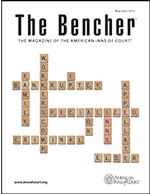The National Success of, and Challenges for, Intellectual Property American Inns of Court
 The Bencher—May/June 2016
The Bencher—May/June 2016
By Professor Timothy R. Holbrook
My first experience with an American Inn of Court was the Giles S. Rich American Inn of Court in Washington, DC, an intellectual property-specific Inn. I was serving as a law clerk on the U.S. Court of Appeals for the Federal Circuit, and I found the programming and camaraderie of the Inn inspiring. At the time, there were at most a handful of IP-specific Inns in the country.
Fast forward almost two decades, and there are now 25 American Inns of Court specializing in intellectual property. The majority of these Inns were founded since 2007. There is even an intellectual property Inn in Japan. That is an amazing amount of growth in a short period of time. Indeed, I had a hand in founding two of these Inns–the Richard Linn American Inn of Court in Chicago and the Atlanta Intellectual Property American Inn of Court.
What explains this explosive growth? In large part, it demonstrates a considerable demand for the purposes of the American Inns of Court generally. More important, it confirms the commitment of Judge Richard Linn of the U.S. Court of Appeals for the Federal Circuit. He has worked diligently to see the spread of these Inns nationally (and internationally). Through the Linn Inn Alliance, he also helps the Inns coordinate among each other, sharing programs and inviting members to attend other Inns’ meetings as guests.
Intellectual property is a fertile area for Inn specialization. Much of intellectual property law—generally viewed as including patents, trademarks, copyright, and trade secrets—involves complex doctrines that have their own lexicon. By focusing on intellectual property lawyers, these Inns can offer programs that dive deeply into these issues without having to provide a primer on them. Programs can jump into the heart of the subject matter without the audience being left behind. It also allows exploration of the various complex ethical issues that can arise, which are often informed by the substantive law at issue.
Because intellectual property is mostly federal law, the issues that arise tend to be national in scope. Consequently, the alliance of IP Inns can readily share ideas for programs, both in terms of style and substance. Such cross-fertilization is helpful, particularly for newer Inns.
Intellectual property practitioners may frequently be on opposite sides of an issue or a case, but Inn membership provides a venue to encourage and build relationships that help improve the profession.
IP Inns are not without challenge. Even though they are specialized, there is a considerable amount of variety. Monitoring the content of the programs is essential to ensure that all members find value from the Inn.
Inns are also challenged to ensure that their membership remains diverse and inclusive. In the patent area, lawyers with scientific or engineering backgrounds abound, but these disciplines are historically underrepresented by women and minorities. Inns need to monitor their membership rolls to ensure they are inclusive. The same is also true with regard to ensuring a cross-section of practitioners, ranging from large firms to solo practitioners.
Finally, because most intellectual property law is federal, outreach to the judiciary can be a challenge. State judges may not be interested in the Inn because they rarely encounter these issues. While I was in Chicago, we had little difficulty having the local federal judges participate. In contrast, it has been more difficult to get the federal judges in Atlanta to participate because IP is not a large part of their docket. IP Inns must continually reach out to judges and explain the importance of the Inn to them.
The explosion of IP-specific American Inns of Court has not been accidental. Their spread shows that there is strong demand for the American Inns of Court, a demand that hopefully is being met.
Timothy R. Holbrook is a professor of law at Emory University School of Law in Atlanta, Georgia.
© 2016 Timothy R. Holbrook. This article was originally published in the May/June 2016 issue of The Bencher, a bi-monthly publication of the American Inns of Court. This article, in full or in part, may not be copied, reprinted, distributed, or stored electronically in any form without the express written consent of the American Inns of Court.